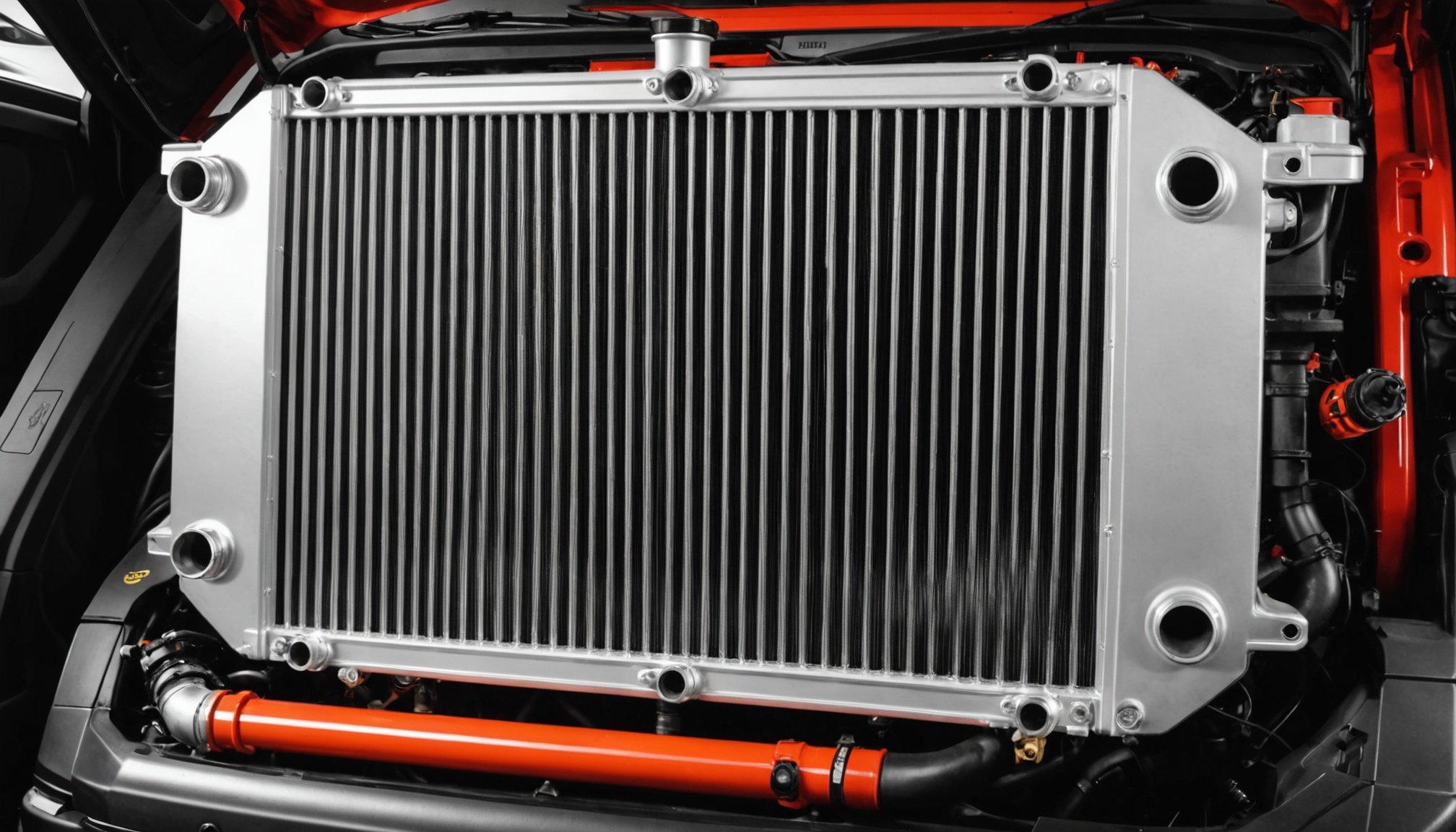Importance of Radiator Upgrades for Ford Focus ST Performance
Enhancing the performance of your Ford Focus ST begins with understanding the relationship between engine cooling and efficiency. The radiator plays a vital role in maintaining optimal temperatures, directly impacting the car’s performance. With stock radiators, overheating can be a recurrent issue due to inadequate cooling efficiency. This not only hinders performance but can also lead to long-term damage and reduced engine longevity.
Radiator upgrades in the Ford Focus ST can significantly mitigate these problems. By improving cooling efficiency, upgraded radiators prevent the engine from reaching excessive temperatures. This ensures the engine runs smoothly, even under strenuous conditions. Upgraded systems are designed to handle more heat, providing a more stable and reliable cooling system.
In parallel : Ultimate Guide to Applying Heat-Resistant Window Film in Your Mercedes-Benz GLE: Tips and Tricks for a Flawless Finish
Moreover, efficient temperature control is crucial for preserving the life of the engine. Lower engine temperatures reduce wear and tear, prolonging engine health and enhancing overall vehicle reliability. In summary, radiator upgrades not only boost Ford Focus ST performance but also offer long-term benefits by safeguarding the engine from potential overheating issues. By investing in a quality upgrade, drivers can enjoy improved performance and increased durability.
Comparing Stock and Aftermarket Radiators
When considering the replacement or upgrade of a radiator, understanding the variations between stock radiators and aftermarket radiators is essential. While both options provide distinct features, a deep dive into their designs, materials, and performance differences can aid in making the most informed decision.
Also read : Boosting Subaru BRZ Handling: The Impact of Installing a Strut Tower Brace
Key Differences in Design and Materials
Stock radiators are typically produced by the original equipment manufacturer and designed with a focus on cost-effectiveness and compatibility. Meanwhile, aftermarket radiators often offer upgraded designs, which may include enhanced cooling capabilities and advanced materials, such as aluminium for improved heat dissipation. These design enhancements can potentially provide better handling of intense driving conditions, aligning with performance goals.
Pros and Cons of Aftermarket Options
Aftermarket radiators come with their own set of benefits, such as customisation options and potentially superior cooling performance. However, there may be concerns regarding fitment and warranty. Unlike stock radiators, which are assured to fit perfectly and often come with a warranty, aftermarket options may require additional adjustments or lack comprehensive warranty coverage.
Performance Metrics to Consider
In making a cost-benefit analysis, evaluate how aftermarket radiators stack up against stock radiators. Consider factors like cooling efficiency, durability, and the demands of particular driving conditions. Those prioritising enhanced cooling for high-performance vehicles may find the investment in aftermarket radiators worth the initial costs due to long-term performance gains.
Benefits of Enhanced Cooling on Engine Performance
Ensuring optimal engine performance requires an effective cooling system. Improved cooling directly impacts the horsepower and torque of an engine. By maintaining lower operating temperatures, engines can run more efficiently, avoiding the power loss typically associated with excessive heat. When an engine overheats, it can lead to pre-ignition and knock, which reduces overall performance, whereas a robust cooling system enables smoother and more powerful operation.
One of the significant cooling benefits is the reduction of heat-related engine failures. Excessive heat can lead to warped cylinders and melted components, resulting in costly repairs and downtime. By keeping temperatures in check, enhanced cooling systems can extend engine life and cut down the risk of critical failures.
Furthermore, there is a notable correlation between engine temperature and fuel efficiency. Lower engine temperatures can improve fuel combustion rates, promoting improved efficiency. This means not only does the engine perform better, but it also consumes less fuel, leading to reduced emissions and operating costs. Therefore, investing in an efficacious cooling system offers multiple rewards, including bolstered performance, reliability, and environmental benefits.
Installation Guide for Radiator Upgrades
When upgrading the radiator in a Ford Focus ST, a structured and careful approach is essential to ensure a smooth process. This DIY guide can assist you in avoiding unnecessary confusion and provide a comprehensive overview of the installation.
Tools and Equipment Needed
Before commencing, gather all necessary tools. A typical radiator installation requires a socket wrench, screwdriver set, pliers, and possibly a funnel. Personal protective equipment such as gloves and safety glasses are also recommended to ensure safety during Ford Focus ST upgrades.
Step-by-Step Installation Process
- Prepare the Vehicle: Ensure the vehicle is cool and park it on a flat surface. Disconnect the battery and drain the current radiator.
- Remove the Old Radiator: Carefully detach all hoses and mounting fasteners. Keep track of screws and clips.
- Install the New Radiator: Fit the new radiator in place, reattach hoses, and fasten securely using a socket wrench.
- Refill and Test: Add coolant gradually, checking for leaks and ensuring the engine reaches optimal temperature.
Common Mistakes to Avoid
Avoid rushing the process as improper installation can lead to leaks and engine overheating. Double-check hose connections and mounting security. A common error is neglecting to bleed the radiator, resulting in air pockets that affect efficiency. Following these guidelines ensures a successful radiator upgrade, enhancing your vehicle’s performance.
Cost Considerations for Radiator Upgrades
When planning for a radiator upgrade, it’s essential to consider the costs involved comprehensively. The decision between stock and aftermarket radiators can heavily influence your overall expenses. Stock radiators, typically sourced from the vehicle manufacturer, may provide a more cost-effective initial purchase due to manufacturer subsidies. However, aftermarket radiators, known for their higher performance and durability, might require a larger up-front investment.
Labor costs play a significant role in the total expenses if professional installation is necessary. Hiring a skilled technician ensures the upgrade is performed correctly, preventing potential issues and long-term savings. It’s worth noting that labor costs can vary widely depending on the complexity of the installation and local market rates.
Finally, while initial upgrade expenses may seem steep, investing in a high-quality radiator can pay off with reduced engine wear over time. Superior cooling performance can extend your engine’s lifespan, leading to fewer repairs and maintenance costs in the future. In essence, though the immediate financial layout may be higher, the long-term benefits and savings can justify the investment.
Testimonials and Reviews from Automotive Enthusiasts
Among automotive enthusiasts, radiator reviews frequently highlight important insights. These reviews often focus on how aftermarket radiators improve vehicle performance. Users who have installed these components note several advantages, such as improved cooling efficiency and enhanced vehicle longevity.
Positive Experiences with Aftermarket Radiators
Many users report noticeable improvements in engine performance and temperature management. Aftermarket radiators are credited with enabling engines to run cooler, especially during high-intensity usage or warmer climates. This difference often equates to enhanced driving experiences and confidence in more challenging environments.
Real-World Performance Improvements
Feedback from users frequently documents how some radiator brands stand out for their build quality and cooling capabilities. Enthusiasts appreciate brands that offer durability and seamless integration with their vehicles, making installation a stress-free process. These performance testimonials underline the practical benefits of choosing reputable radiator manufacturers.
Considerations from Other Users
However, some users caution about specific challenges, such as compatibility and installation. Common themes in reviews include the importance of researching whether a radiator fits a particular vehicle model and verifying installation procedures. These insights reinforce the necessity of meticulous preparation when considering radiator upgrades to achieve optimal performance outcomes.
Technical Explanation of Cooling System Dynamics
Understanding the cooling system dynamics is crucial for maintaining optimal engine temperature control and ensuring the radiator functionality is at its best. At the heart of this process is the radiator, which cools the engine fluids that have absorbed heat from the engine.
The coolant plays a pivotal role, circulating through the engine and absorbing excess heat. As it passes through the radiator, it releases this heat into the air. The efficiency of this heat exchange directly impacts how well the cooling system performs, ultimately influencing the engine’s longevity and efficiency.
Efficient engine temperature control depends not just on the coolant itself, but also on the system’s ability to maintain consistent fluid flow. Blockages or leaks can significantly diminish cooling efficiency, leading to engine overheating and potentially severe damage.
A well-functioning cooling system directly enhances vehicle performance by preventing temperature-related inefficiencies or breakdowns. Regular maintenance checks are advised to ensure the radiator and associated components are in perfect working order, promoting optimal engine performance. This intricacy underlines the indispensable role of the cooling system in vehicle operations.






